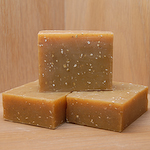Processes to Make Soap: Soap Saturdays
This is a continuation of a series of posts about soap related topics. Last week we talked about the beginning of a soap maker, deciding what kind of soap you wanted to produce, and it's specific purpose as a start.
What are the different processes for making soap? Here are the ones that I'm aware of:
- Cold Process
- Hot Process
- Melt and Pour
- French Milled
- Liquid Soaps
 Cold Process Soap: The only soap that I am really familiar with is cold process soap. That is what we do at Horse 'O Peace Ranch, and that is what I had my heart set on to try from the beginning 5 years ago. Cold process soap takes your ingredients of oils or fats, liquids, and lye, and turns them into soap at a very low temperature. After making and cutting the soap, it cures for a minimum of 4-6 weeks.
Cold Process Soap: The only soap that I am really familiar with is cold process soap. That is what we do at Horse 'O Peace Ranch, and that is what I had my heart set on to try from the beginning 5 years ago. Cold process soap takes your ingredients of oils or fats, liquids, and lye, and turns them into soap at a very low temperature. After making and cutting the soap, it cures for a minimum of 4-6 weeks.
Hot Process Soap: I've only read about hot process soap, but it basically is made in the same way as the cold process soap, only it is "cooked" to remove some of the moisture and the result is soap that cures in half the time of cold process soap. Some soap makers prefer this method because they enjoy using their creations sooner than the cold process soap making crowd.
 Melt and Pour Soap: This is where you can buy a soap base or glycerin, and literally melt it down, add your own scents, herbs, colorants, toys, etc., and pour it into a base to harden before use.
Melt and Pour Soap: This is where you can buy a soap base or glycerin, and literally melt it down, add your own scents, herbs, colorants, toys, etc., and pour it into a base to harden before use.
 French Milled Soap: Also known as triple-milled, hand-milled or rebatched soap. You take a bar of soap that has already been made and fully cured (can be homemade or commercial soap) grate it down to shavings, add some water, maybe some fragrance if you prefer, and ta-da! you have a new kind of soap. Super easy! It still needs a few weeks of curing though, from adding water to the soap again.
French Milled Soap: Also known as triple-milled, hand-milled or rebatched soap. You take a bar of soap that has already been made and fully cured (can be homemade or commercial soap) grate it down to shavings, add some water, maybe some fragrance if you prefer, and ta-da! you have a new kind of soap. Super easy! It still needs a few weeks of curing though, from adding water to the soap again.
 Liquid Soaps: One day I'm determined to getting around to trying my hand at liquid soap, but for the last 5 years I've been busy enough with bar soaps. Liquid soap has a similar start to making cold or hot process soap, but you cook it down to a paste, then rehydrate it with water or milk. Some people prefer liquid soap to bar soaps (usually because they don't like the experience of commercial bar soaps that leave a "film" on your skin that doesn't rinse off cleanly). (Actually, my husband was one of these people who never used bar soap. Then when I came along, I noticed my soap was disintegrating unusually quickly and he 'fessed up to using it. He liked it so much he's never used liquid soaps again!).
Liquid Soaps: One day I'm determined to getting around to trying my hand at liquid soap, but for the last 5 years I've been busy enough with bar soaps. Liquid soap has a similar start to making cold or hot process soap, but you cook it down to a paste, then rehydrate it with water or milk. Some people prefer liquid soap to bar soaps (usually because they don't like the experience of commercial bar soaps that leave a "film" on your skin that doesn't rinse off cleanly). (Actually, my husband was one of these people who never used bar soap. Then when I came along, I noticed my soap was disintegrating unusually quickly and he 'fessed up to using it. He liked it so much he's never used liquid soaps again!).
There you have it. Decide what process suits the purpose of the soap you want to make, and we'll start covering equipment and ingredients in the next few Soap Saturdays.





